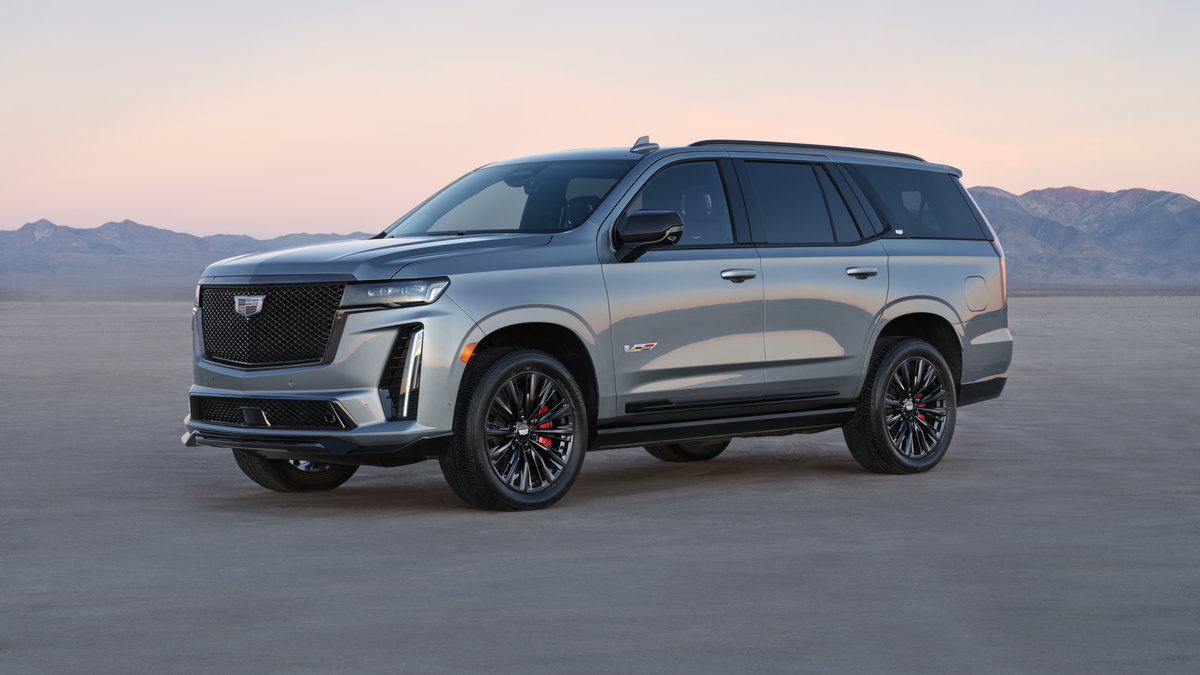How Cadillac Engineers Made the Escalade-V Work

Photo: Cadillac
Last week, Cadillac unleashed lots of Escalade-V details and specs on the world. This 6,300-pound hot-rod SUV has a 6.2-liter LT4 supercharged V8 making 682 horsepower and 653 lb-ft of torque, and is promised to do 0-60 in under 4.4 seconds thanks to full-time all-wheel drive. It’s the most powerful street vehicle Cadillac has ever made.
How did GM manage to make it all work together? To find out, I sat down with two key engineers who have been working on the Escalade-V since development began in 2018: Howard Smith, performance variant manager at Cadillac, and Charlie Allen, an engine design system manager on Escalade-V.
Photo: Cadillac
You may have assumed that the 6.2-liter supercharged V8 under the Escalade-V’s hood is the same engine powering the raucous Cadillac CT5-V Blackwing, but that’s not entirely the case. Remember, the high-performance Escalade gets 14 more horses (and six fewer lb-ft of torque) than Caddy’s top-dog muscle sedan.
The biggest difference is the supercharger. The Escalade gets a 2.65-liter Eaton TVS R2650 belt-driven blower, similar but not identical to what’s found in the 750-hp C7 Corvette ZR1. The Escalade-V’s supercharger is nearly a full liter larger than the 1.7-liter unit in the CT5-V Blackwing, and carries larger charge-air coolers (compared to the CT5) in its lid.
G/O Media may get a commission
31% Off
AstroAI Digital Tire Inflator
Top up your tires before you drive
Don’t risk heading out on the road with tires that are less than perfect. This digital tire inflator gives you an accurate read of your PSI, and lets you top up your tires from home.
The Escalade-V also gets an electronically-controlled bypass valve to improve drivability with the larger supercharger. Allen explains that this bypass valve, infinitely adjustable and controlled by the ECU, more precisely manages the pressurized air coming into the engine, making for a smoother driving experience.
Photo: Cadillac
The bigger supercharger isn’t just about more power, though that’s a nice fringe benefit. As Allen explains, the Escalade’s design makes for more restrictive intake and exhaust routing — there’s no gaping hood scoop on the Escalade-V, and the sheer length of this thing means the exhaust has to travel a long way to get to the tailpipe.
While the CT5-V Blackwing makes more peak torque, the supercharged Escalade delivers that grunt in a way that’s more accessible to an SUV driver.
Photo: Cadillac
“The Escalade-V engine makes approximately 80 percent of its peak torque at just 2,000 rpm,” Allen said. “That awesome low-speed torque really makes for a fun driving experience for the driver.”
Photo: Cadillac
A unique accessory-drive layout (which required small changes to the block itself) and new oil pan and exhaust manifolds make the Escalade-V’s LT4 unique from previous versions, all in the name of packaging.
Of course, that power is useless if you can’t get it to the ground. The 10-speed automatic was reinforced to handle the Escalade-V’s torque, and the transfer case gets a larger front output bearing. Some driveline components come directly from GM’s heavy-duty pickup trucks, though engineers didn’t specify exactly which parts they were referring to.
There were lots of challenges in making a vehicle like this work. According to Smith, the toughest was finding a way to make 682 horsepower and 653 lb-ft of torque feel manageable – especially on launch.
Photo: Cadillac
Engineers had to do a lot of work to make sure this behemoth could go around a corner. They made changes to sharpen the Magnetic Ride 4.0 electronic dampers as well as steering response. The chassis tweaks were meant to combat pitch and roll in corners and give the Escalade-V more body control on hard launches. The new SUV has three drive modes: Tour, Sport and V-Mode, with rising levels of aggressiveness.
Exhaust sound was a major priority of the engineering team. They wanted it to really sound like a performance vehicle. That meant some pretty big changes to the standard Escalade’s exhaust. Engineers changed the exhaust manifolds, twin catalytic converters and quad exhaust tips. The truck also comes with dual exhaust valves, allowing for quiet and loud modes, so your neighbors and loved ones don’t hate you in the morning.
“The first time you hear the exhaust note in sport mode, you’re going to have a big smile on your face,” Allen said. “Just like I did.”



